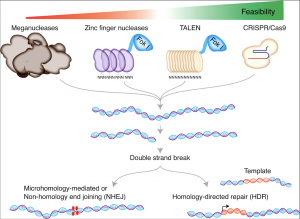Gene Editing
Genome Editing, also known as gene editing, is a group of technologies under genetic engineering that gives scientists the ability to change an organism’s DNA. This group of technologies enable genetic material to be added, removed, or altered at particular locations in the genome. Several methods of implementing foreign DNA into an organism's existing genome have been utilized in the past, however, the most recent is called Crispr-Cas9. Short for clustered regularly interspaced short palindromic repeats and CRISPR-associated protein 9, the Crispr-Cas9 system has generated a lot of excitement among the scientific community as it has been the fastest, cheapest, most accurate and efficient means of altering DNA compared to its predecessors. Genome editing is of great interest in the prevention and treatment of human diseases. Currently, most research on genome editing is done to understand diseases using cells and animal models. Scientists are still working to determine whether this approach is safe and effective for use in people. It is being explored in research on a wide variety of diseases, including single-gene disorders such as cystic fibrosis, hemophilia, and sickle cell disease. It also holds promise for the treatment and prevention of more complex diseases, such as cancer, heart disease, mental illness, and human immunodeficiency virus (HIV) infection. [1]
History
Use of Gene Editing
References
- ↑ "What Are Genome Editing and CRISPR-Cas9?" NIH.” U.S. National Library of Medicine, National Institutes of Health, 3 Mar. 2020.
